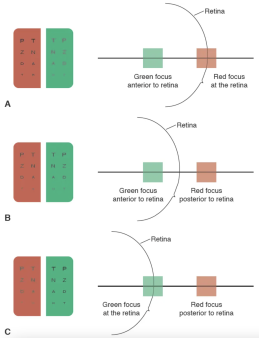Duochrome Test
All content on Eyewiki is protected by copyright law and the Terms of Service. This content may not be reproduced, copied, or put into any artificial intelligence program, including large language and generative AI models, without permission from the Academy.
Introduction
Chromatic aberration, the basis of the test, occurs because different wavelengths of light are bent to a different extent. The duochrome test involves the projection of black letters or symbols onto a bipartite green (at approximately 535nm) and red (at approximately 620 nm) background. The red and green wavelengths are dioptrically equidistant, approximately 0.25 D, from the yellow wavelength (570 nm). The longer wavelength (red) is refracted less than the shorter (green). It is assumed that best vision is attained when the yellow wavelengths are focused on the retina. During the final sphere adjustment, it is important to find the least minus that a patient will accept in order to ensure that accommodation is minimized, particularly in myopic patients. The eye typically focuses near the midpoint of the spectrum, between the red and green wavelengths. With optimal spherical correction, the letters on the red and green halves of the chart appear equally sharp.
Indications
Contraindications
The duochrome test is not used with patients whose visual acuity is worse than 20/40, because the 0.50 D difference between the 2 sides is too small to distinguish.
Equipment
Procedure
- The patient is first assessed with refraction and given the best correction.
- With that correction in the phoropter or trial frames in place, the duochrome chart can then be projected.
- The test starts by occluding one eye (left eye first by convention)
- Room lights must be turned off in order to allow the pupil to dilate which would allow for increase chromatic aberration of the eye
- Ask the patient to compare the letters on green and red sides of the test
- If the letters on the red side stand out more continue to add more minus power using -0.25 DS steps
- If the letters on the green side stand out more continue to add more plus power using +0.25 DS steps
- Neutrality is reached when the letters on both the red and the green background appear equally distinct.
- IF more than +/- 0.5D is required to balance then the test is unreliable
RAM–GAP mnemonic: Red Add Minus; Green Add Plus
Interpretation
Some authors suggest a rule of thumb in these cases is to leave younger patients one step into the green, older patients one step into the red, and pseudophakic patients one step into the green.
The Red-Green duocohrome test is traditionally recommended to verify the spherical endpoint. It may be used prior to determining the cylindrical component of the refraction using a Jackson Cross Cylinder (JCC) and subsequent to this determination.


